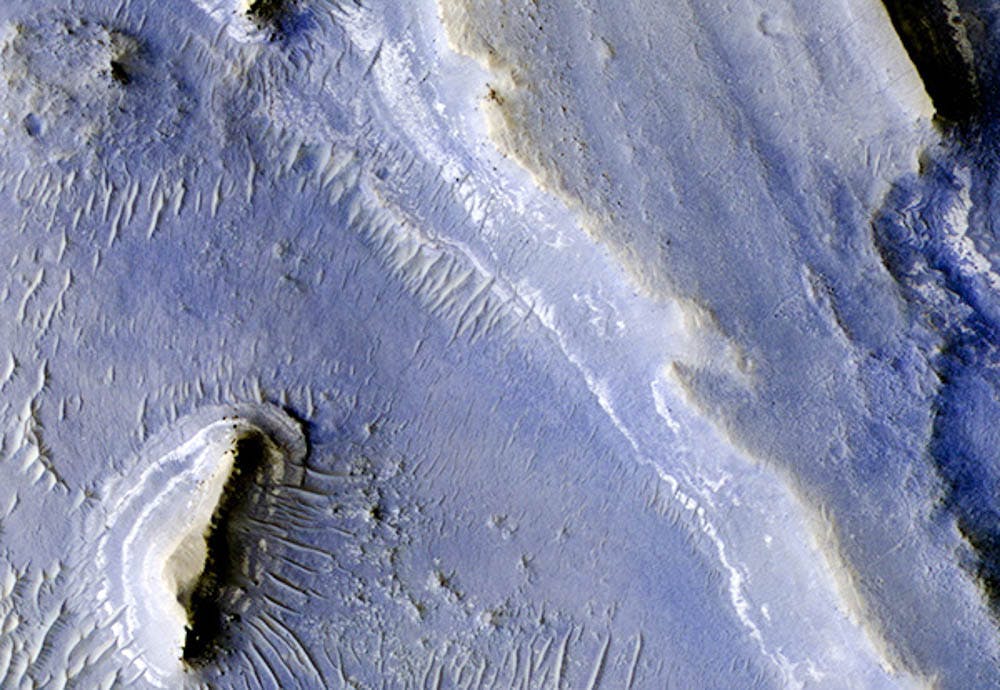Identifying life on Mars may be within reach thanks to University researchers’ new findings of hydrated silica on the red planet. The answer to the question of extraterrestrial life could lie buried in this compound, preserved for future analysis by the 2020 Mars rover. Hydrated silica could encase the fossils of life forms that ages ago floated in the lake believed to have once filled the Jezero crater on Mars.
Researchers discovered the presence of the hydrated silica deposits while analyzing the mineral composition of Mars’ surface in Jezero, Northeast Syrtis and Midway — once considered potential landing sites for the 2020 rover — using space imaging techniques, lead author of the study Jesse Tarnas GS and co-author Mike Bramble GS said. The discovery was significant given the compound’s capacity to preserve life forms.
The team, most of whom work in the lab of John Mustard, professor of Earth, Environmental and Planetary Sciences and professor of Environmental Sciences, used data from the High Resolution Imaging Science Experiment camera, which creates high resolution images to determine the geological makeup of the sites, Bramble said. The camera employs red, green and infrared light to capture photographs of the different regions of Mars. The exact minerals that compose each location on Mars’ surface, however, were identified through the Compact Reconnaissance Imaging Spectrometer for Mars, Bramble said. The Reconnaissance Orbiter has been circling Mars since 2006 and is a spacecraft designed to gather information about potential landing sites, according to NASA’s website.
CRISM uses a technique known as reflectance spectroscopy, in which infrared light — that has wavelengths exceeding those of visible light — beams toward the planet and bounces off as a different wavelength that corresponds to the minerals it hits. This returning light is then detected and analyzed. Tarnas, alongside co-author Honglei Lin, had previously created a technique for interpretation of the data that narrowed the size of the regions captured and studied by CRISM. The application of this analysis system to images taken in 2007 from, in and around the Mars 2020 rover’s landing region led to the discovery of the silica compound in the area.
“We’re trying to make these new techniques that allow us to think like a rover from orbit so that we can help guide the rover in the best locations to go,” Tarnas said.
The imaging technique is reminiscent of the technique used in archaeology on Earth, except it identifies individual compounds on Mars instead of underground structures revealed by hydration of soil, for example, Bramble said.
Hydrated silica’s hardness and resistance to harsh environmental conditions and dissolution enhances its ability to preserve fossils. “Silica’s really interesting … because it’s better at preserving biosignatures for long periods of time than any other mineral on Earth,” Tarnas added. On Earth, the compound has been known to preserve ancient fossils; the flora and fauna from over 3.4 billion years ago have been found as white imprints in hydrated silica in areas such as South Africa and Australia.
On Mars, the material is not unique to Jezero. The Spirit rover detected traces on the other side of the planet in 2008, Milliken said.
This development was exciting at the time since it confirmed beliefs that silica and the stone containing it, opal, existed on the planet, said Assistant Professor of Earth, Environmental and Planetary Sciences Ralph Milliken, who did not participate in the study. Milliken used CRISM to identify the presence of opal on the surface around the same time. But the conditions under which this silica originated were unknown. It could have formed from extremely hostile conditions not conducive to life, such as acidic or volcanic conditions.
In contrast to the formerly identified regions, silica’s presence around Jezero offers the unique opportunity to analyze remnants from a historically aquatic environment, Tarnas said.
“We’ve keyed in where the habitable environments are. Now we’ve keyed in where the minerals are that are really good at preserving the biosignatures. Now we just need to send the technology there and ask nature the question by looking and (seeing) what nature presents us with,” Tarnas said.
The hydrated silica preserves would have originated in Northeast Syrtis and settled as sediment in Jezero, said Bramble, who helped interpret the images.
Once the Mars 2020 rover descends on the red planet in February 2021 after its departure from Earth next July, it will scour the area in search of the hydrated silica, Tarnas said. The rover will proceed to extract and bring home 38 silica samples for further analysis and identification.
“The big thing is this mission is going there soon, and so it provides a framework for scientists investigating mineralogy in this region both to help guide what to look for … and what path to go down to correctly identify what’s on the surface,” Bramble said.
“It’s super exciting … to be able to get more detailed information about the mineralogy and the rock types that are present in this location on Mars, because we are sending this big, exciting new rover there … so we’ll actually have the capability to test some of these hypotheses,” Milliken said.
Furthermore, if no fossils are found within these samples, that does not rule out the possibility of life on the planet since it may have just been absent in that specific area, or the conditions may not have been suitable for preservation, Milliken added.
But the scientific community and everyone else back down on the ground will have to wait until the 2030s before receiving any official confirmation of ancient life on the neighboring planet, if there is any.





